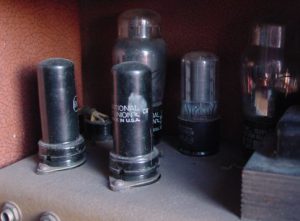Practice Your Scales
By Curtis McCormick
 I find practicing scales and fingerings on the guitar pretty boring but it must be done if one is to improve. With a full-time job, a side job and a wife to spend time with, I had trouble finding the time to do that guitar practice until I hit upon a good formula.
I find practicing scales and fingerings on the guitar pretty boring but it must be done if one is to improve. With a full-time job, a side job and a wife to spend time with, I had trouble finding the time to do that guitar practice until I hit upon a good formula.
I realized that the time I spent with my wife watching TV in the evenings after our jobs could be put to better use than just mindlessly watching the telly. I explained to her that I needed to quietly practice on the couch next to her, if that was okay, in order to keep myself happy, while we watched TV. Luckily, she felt my happiness was important to both of us and she agreed, as long as I was quiet.
So, I use an old Harmony Strat copy, unplugged, and a Dr. Rhythm Drum Machine with headphones to quietly improve my skills while we spend time together watching TV.
The strings on the Harmony are pretty high off the fingerboard and it won’t go in tune enough to play chords but that difficulty in playing is perfect for skill building; when I play a good guitar with low action, I can really zip around!
I set the drum machine on a four beat to the bar metronome pattern and start off with fingerings, not even scales, with up and down picking designed to limber up and strengthen my hands.
I use the entire necks with lots of variations such as string skipping…etc, to make it interesting and difficult while speeding up the tempo of the metronome a tiny bit when my skills can support that increase.
This takes about half an hour and then I move onto scales. I’m a blues player so it’s mostly pentatonics with a few extra notes thrown in here or there depending on whether I’m working on a major or minor feel.
I’ll do about a half hour with first one scale position and then start to work the next higher position into my practicing.
By now, I’m pretty tired of the skill building bit so I’ll move onto playing actual music to a drum pattern that I might find motivating to jam to.
I’ll set a chord pattern up, something basic like Am going slowly to D, and play that for a bit until it’s imprinted in my imagination.
I then try to dart lead lines in between the chords, while making sure I get back into position to hit the chords on time.
Doing that, and endless variations on other similar themes, with no accompaniment other than the drum machine really makes me work hard.
I’ve been doing this type of thing, mostly every day, for about a year now and it has made me a much better player in every way possible.
I’ve been playing guitar for 30 years and have never worked so hard at it or sounded better!
Check out Curtis McCormick’s Blog http://dustyoldamp.wordpress.com/
RECOMMENDATIONS:
Beatles Guitar Chord Songbook. Either volume, A-I or J-Y, it doesn’t matter; the bible on how chords work together. Hal Leonard Publishing.
My 1939 Supertone tube amp – from beautiful clean to ragged glory, it’s a one-knob wonder that keeps me honest. It truly amplifies the skills, either good or bad, of the player and forces one to improve or stop playing through it.
My Yamaha FG730s – no better way to pass the time than to write songs and no better way for me to see if a song is good or not than to play it on acoustic with no other accompaniment.
Head Above Music Recommendations:
Integral Guitar: An Integrated Course of Practice and Theory Including Scale and Chord Fingerings

